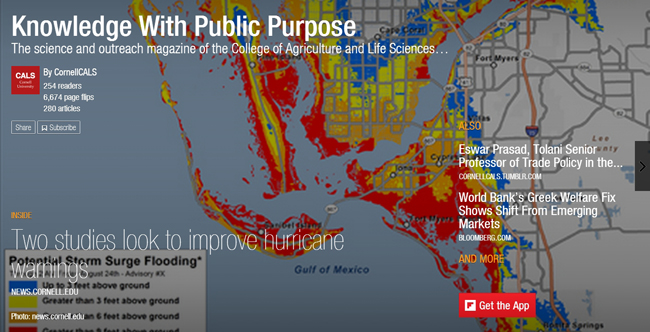Projects, 10 in total, focus on response to coastal storm hazard information
Contacts:
Krishna Ramanujan, Cornell Chronicle, P: 607-255-3290, E: ksr32@cornell.edu
Melissa Osgood, Cornell Media Specialist, P: 607-255-2059, E: mmo59@cornell.edu
Barbara A. Branca, New York Sea Grant, Communications Manager, E: barbara.branca@stonybrook.edu, P: 631-632-6956

An example of a Potential Storm Surge Flooding Map for the Fort Myers area in Florida. Its experimental use will begin this year. Officials and researchers hope it will help to better inform the public about storm surge hazards. Photo: NOAA
In addition to being a feature in the Cornell Chronicle, this story also made it into "Knowledge With Public Purpose," an all-digital Flipboard magazine produced by the Cornell College of Agriculture and Life Sciences. With a focus on research and extension, this CALS-curated magazine offers an easy and enjoyable new way for visitors to stay on top of the scientific discovery and outreach happening at one of the world’s leading colleges of agriculture and life sciences.
Ithaca, NY, February 3, 2014 - The National Oceanic and Atmospheric Administration (NOAA) and Sea Grant have funded two Cornell projects to help officials improve coastal hazard warnings for residents in New York, New Jersey and Connecticut.
One project assesses how people in coastal communities respond to storm hazard information, and the other measures how individuals understand, react and respond to media messages about storm surges.
Each project received about $150,000 out of a total $1.4 million from NOAA/Sea Grant’s Hurricane Sandy relief money that funded 10 projects.
The first project seeks to understand the behaviors behind people’s intentions to evacuate, considering that some 100 people died during Hurricane Sandy after ignoring evacuation warnings, said Jonathon Schuldt, Cornell assistant professor of communication and co-principal investigator with Linda Nozick and Philip Liu, both Cornell professors of civil and environmental engineering. Ricardo Daziano, the David Croll Fellow Assistant Professor in the Department of Civil and Environmental Engineering, is the project leader.
The group will test the effectiveness of traditional and social media such as Facebook for disseminating storm information; visual vs. textual information; different versions of hurricane tracking maps; and different ways of framing information about the storm and its effects, such as anticipated severity.
In a second phase, the team will leverage their understanding of best uses of social media and other messaging strategies. They also will conduct a representative survey of coastal residents in New York, New Jersey and Connecticut.
The group hopes to develop “a set of best practices or guidelines that we can use to advise officials who are creating these message strategies and hopefully make them a little more effective,” said Schuldt.
The second project will investigate how coastal residents in the tri-state region perceive risk from storm surge and hurricanes through media messages. During Sandy, 40 deaths were directly attributed to flooding that occurred due to storm surge.
The Cornell-led team will develop hurricane forecast videos that incorporate a new storm surge inundation map created by the National Hurricane Center. The map displays the predicted amount of storm surge above ground at each specific location along the hurricane track, with colored zones for denoting levels of water.
With many risks – high winds, tornadoes, storm surges and flooding – relayed during a TV newscast warning of a hurricane, the team seeks to understand if “audiences have sufficient time to assess and process storm surge information and make related decisions,” said Gina Eosco, a graduate student in the field of communication and an investigator in the study. The project’s principal investigators include Clifford Scherer, associate professor of communication, and Laura Rickard, Ph.D. ’12, an assistant professor of environmental studies in the State University of New York’s College of Environmental Science and Forestry in Syracuse.
Along with an online survey, project members are working with local broadcast meteorologists to develop a 10-minute experimental weather report to show to focus groups in New York, New Jersey and Connecticut. Participants will each use a handheld real-time response device, the kind often used to gauge perceptions during political debates. Participants will be asked to identify when they feel a hurricane risk might impact them or their family, based on the report. The aim is “to improve storm surge communication for future events and save lives as well,” said Eosco.
More Info: New York Sea Grant
New York Sea Grant (NYSG), a cooperative program of Cornell University
and the State University of New York, is one of 33 university-based
programs under the National Sea Grant College Program (NSGCP) of the
National Oceanic and Atmospheric Administration (NOAA). The NSGCP
engages this network of the nation’s top universities in conducting
scientific research, education, training and extension projects designed
to foster science-based decisions about the use and conservation of our
aquatic resources. Through its statewide network of integrated
services, NYSG has been promoting coastal vitality, environmental
sustainability, and citizen awareness about the State’s marine and Great
Lakes resources since 1971.
For updates on Sea Grant activities: www.nyseagrant.org has RSS, Facebook, Twitter, and YouTube links. NYSG also offers a free e-list sign up via www.nyseagrant.org/coastlines for NY Coastlines, its flagship publication, which, in 2014, merges with the program's e-newsletter, Currents. NY Coastlines is published several times a year.